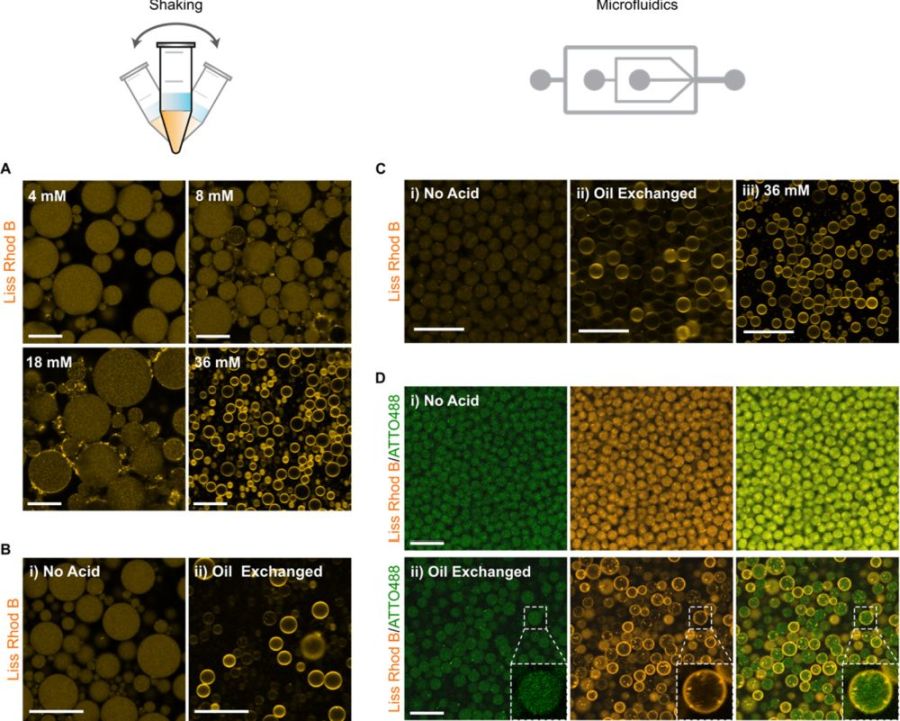
15 Dec Droplet microfluidics for assembly of endomembrane multicompartments
“By using electrostatic interactions as driving force to assemble vesicles, the droplet-stabilized method was recently applied to reconstitute and encapsulate proteins, or compartments, inside giant unilamellar vesicles (GUVs) to act as minimal synthetic cells. However, the droplet-stabilized approach exhibits low production efficiency associated with the troublesome release of the GUVs from the stabilized droplets, corresponding to a major hurdle for the droplet-stabilized approach. Herein, we report the use of pH as a potential trigger to self-assemble droplet-stabilized GUVs (dsGUVs) by either bulk or droplet-based microfluidics. Moreover, pH enables the generation of compartmentalized GUVs with flexibility and robustness. By co-encapsulating pH-sensitive small unilamellar vesicles (SUVs), negatively charged SUVs, and/or proteins, we show that acidification of the droplets efficiently produces dsGUVs while sequestrating the co-encapsulated material. Most importantly, the pH-mediated assembly of dsGUVs significantly improves the production efficiency of free-standing GUVs (i.e., released from the stabilizing-droplets) compared to its previous implementation.”

” Assembly of dsGUVs by acidification from the oil–surfactant phase via the bulk shaking method or microfluidics. (A) Representative confocal fluorescence images of pH-sensitive SUVs [DOBAQ/DOPG/DOPC/Liss Rhod B labeled-DOPE (60/20/19.5/0.5 mol %)] within W/O droplets stabilized by 1.4 wt % PEG-based fluorosurfactant and 10 mM Krytox in HFE-7500 oil that contains various concentrations of acetic acid (4, 8, 18, and 36 mM). Droplets were produced by the bulk shaking method and the aqueous phase consisted of 1.5 mM SUVs in 50 mM KH2PO4/K2HPO4, 75 mM KCl, pH 7.4. Scale bars, 50 μm. (B) Following droplet production by a bulk shaking method (i), the oil–surfactant mixture was exchanged by the acidic oil–surfactant mix supplemented with 36 mM acetic acid, thus provoking the rapid assembly of a supported lipid bilayer at the droplet periphery (ii). Scale bar, 50 μm. (C) Sequential assembly of dsGUVs via a microfluidic mechanical splitting module by entrapping SUVs in a droplet with an oil–surfactant mix without supplementing acetic acid (i) and following the substitution of the oil phase by an acidic oil containing 36 mM acetic acid (ii). Alternatively, assembly of dsGUVs produced by microfluidics splitting can be achieved through the direct usage of an acidic oil containing 36 mM acetic acid as the continuous phase (iii). Scale bars, 25 μm. To minimize droplet coalescence under acidic oil conditions, the oil phase contained 3 wt % PEG-based fluorosurfactant and 10 mM Krytox and 35 mM acetic acid in HFE-7500. (D) Assembly of multicompartment dsGUVs by microfluidic mechanical splitting through post-production acidification. Droplets encapsulated two SUV populations: 1.5 mM SUVs composed of DOBAQ/DOPG/DOPC/Liss Rhod B labeled-DOPE (60/20/19.5/0.5 mol %) and 1 mM of QpaDOPE/ATTO 488-labeled DOPE (99.5/0.5 mol %), both in 50 mM KH2PO4/K2HPO4, 75 mM KCl, pH 7.4. The oil–surfactant mixture was composed of 3 wt % PEG-based fluorosurfactant and 10 mM Krytox in HFE-7500 (Top). Following the production and collection of the dsGUVs, the oil phase was substituted by an acidic oil, initiating the rapid and selective fusion of DOBAQ SUVs to the droplet periphery (bottom). Scale bars, 25 μm.” Reproduced under Creative Commons Attribution 4.0 International License from Lussier, F., Schroter, M. et al. pH-Triggered Assembly of Endomembrane Multicompartments in Synthetic Cells. ACS Synth. Biol., (2021). DOI: 10.1021/acssynbio.1c00472.
Read the original article: pH-Triggered Assembly of Endomembrane Multicompartments in Synthetic Cells


